Rio Olympic water badly polluted, even far offshore
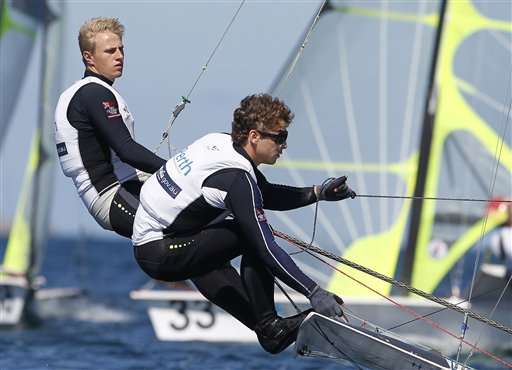
Olympic sailor Erik Heil floated a novel idea to protect himself from the sewage-infested waters he and other athletes will compete in during next year's games: He'd wear plastic overalls and peel them off when he was safely past the contaminated waters nearest shore.
Heil, 26, was treated at a Berlin hospital for MRSA, a flesh-eating bacteria, shortly after sailing in an Olympic test event in Rio in August. But his strategy to avoid a repeat infection won't limit his risk.
A new round of testing by The Associated Press shows the city's Olympic waterways are as rife with pathogens far offshore as they are nearer land, where raw sewage flows into them from fetid rivers and storm drains. That means there is no dilution factor in the bay or lagoon where events will take place and no less risk to the health of athletes like sailors competing farther from the shore.
"Those virus levels are widespread. It's not just along the shoreline but it's elsewhere in the water, therefore it's going to increase the exposure of the people who come into contact with those waters," said Kristina Mena, an expert in waterborne viruses and an associate professor of public health at the University of Texas Health Science Center at Houston. "We're talking about an extreme environment, where the pollution is so high that exposure is imminent and the chance of infection very likely."
In July, the AP reported that its first round of tests showed disease-causing viruses directly linked to human sewage at levels up to 1.7 million times what would be considered highly alarming in the U.S. or Europe. Experts said athletes were competing in the viral equivalent of raw sewage and exposure to dangerous health risks almost certain.
The results sent shockwaves through the global athletic community, with sports officials pledging to do their own viral testing to ensure the waters were safe for competition in next year's games. Those promises took on further urgency in August, after pre-Olympic rowing and sailing events in Rio led to illnesses among athletes nearly double the acceptable limit in the U.S. for swimmers in recreational waters.
Nevertheless, Olympic and World Health Organization officials have flip-flopped on promises to carry out viral testing in the wake of the AP's July report.
Now, the AP's most recent tests since August show not only no improvement in water quality—but that the water is even more widely contaminated than previously known. The number of viruses found over a kilometer from the shore in Guanabara Bay, where sailors compete at high speeds and get utterly drenched, are equal to those found along shorelines closer to sewage sources.
"The levels of viruses are so high in these Brazilian waters that if we saw those levels here in the United States on beaches, officials would likely close those beaches," Mena said.
Brazilian, Olympic and WHO officials now say Brazil needs only to carry out testing for bacterial "markers" of pollution to determine water quality. That's the standard used by nations around the globe, mostly because it's been historically easier and cheaper.
"The health and safety of athletes is always a top priority and there is no doubt that water within the field of play meets the relevant standards," the Rio 2016 Olympic organizing committee said in an emailed statement Tuesday. "Rio 2016 follows the expert advice of the World Health Organization, whose guidelines for Safe Recreational Water Environments recommend classifying water through a regular program of microbial water quality testing."
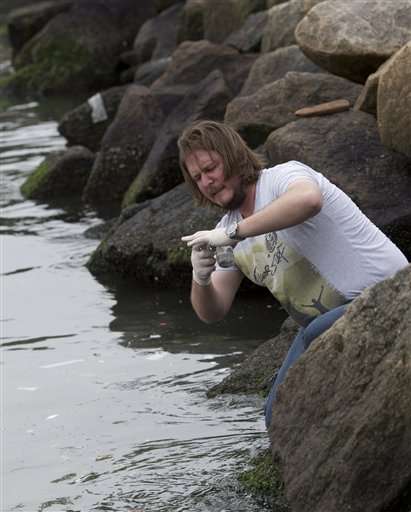
However, in recent years technological advances have made it simpler and less expensive to monitor viral levels, too.
That's why many in the scientific communities in the U.S. and Europe are pushing for legislation that would require viral testing of water. They argue that repeated studies dating back decades have shown little to no correlation between the levels of bacteria pathogens in water, which quickly break down in salty and sunny conditions like those in tropical Brazil, and the presence of viruses, which have been shown to last for months, and in some cases years.
That disparity has surfaced in AP's testing in Rio, where the water often falls within safe levels of fecal bacteria, but the same water sample shows levels of viruses akin to raw sewage. Many of the testing points show spikes in bacterial contamination, too—especially in the Olympic lagoon and in the marina where sailors launch crafts.
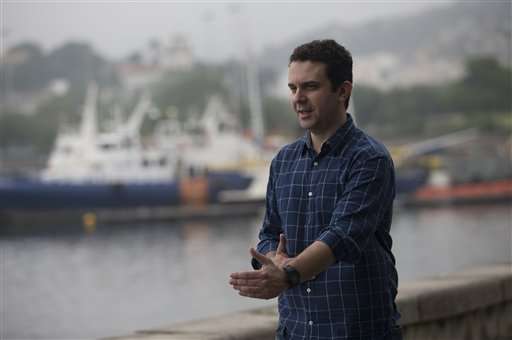
Rio's waterways, like those of many developing nations, are extremely contaminated because most of the city's sewage is not treated, let alone collected. Massive amounts of it flow straight into Guanabara Bay. The Rodrigo de Freitas Lagoon and the famous Copacabana Beach also are heavily contaminated.
Rio won the right to host the Olympics based on a lengthy bid document that promised to clean up the city's scenic waterways by improving sewage sanitation, a pledge that was intended to be one of the event's biggest legacies.
Brazilian officials now acknowledge that won't happen.
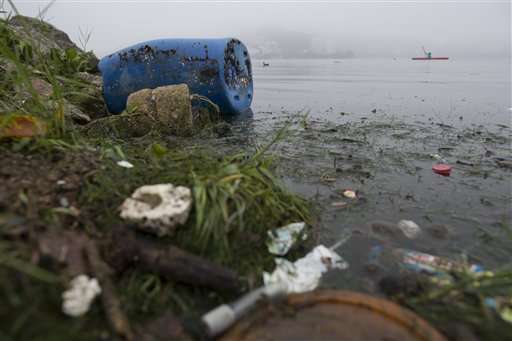
The AP's first published results were based on samples taken along the shores of the lagoon where rowing and canoeing events will be held. Other samples were drawn from the marina where sailors enter the water and in the Copacabana Beach surf, where marathon and triathlon swimming will take place. Ipanema Beach, popular with tourists and where many of the expected 350,000 foreign visitors will take a dip during the games, was also tested.
Since then, the AP expanded its testing to include offshore sampling sites inside Olympic sailing courses in Guanabara Bay and in the middle of the lagoon where rowing and canoeing lanes were located during recent test events.
The tests found the lagoon and bay to be consistently virus-laden throughout, but it also captured a spike in the bacterial fecal coliforms in the lagoon—to over 16 times the amount permitted under Brazilian law.
Mena, the waterborne virus expert, said it makes sense for athletes to think that deeper into the bay and lagoon would be safer, but the testing doesn't bear that out.
"One would expect to see more fluctuations with the levels of any pathogen in the water, but it's not there," she said.
As a result, none of the venues are fit for swimmers or boaters, she said. Athletes who ingest three teaspoons of water have a 99 percent chance of being infected by viruses.
That assessment was echoed by Brazilian virologist Fernando Spilki, coordinator of the environmental quality program at Feevale University in southern Brazil, who is conducting monthly tests for the AP.
"Samples from the sailing courses and inside the lagoon prove that the viruses are present even away from the shore, away from the sources of pollution, and that they maintain extremely high viral loads," he said.
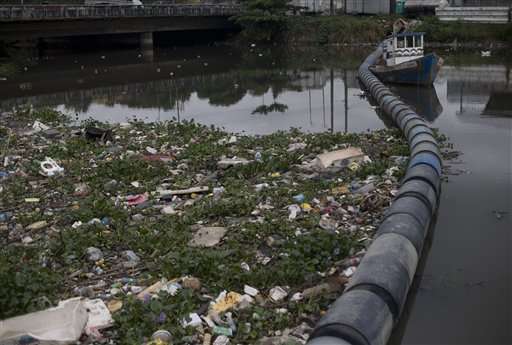
Athletes in Rio test events have tried many tricks and treatments to avoid falling ill, including bleaching rowing oars, hosing off their bodies the second they finish competing, and preemptively taking antibiotics—which have no effect on viruses.
Despite those efforts, athletes at a competition in August still fell ill. The World Rowing Federation reported that 6.7 percent of 567 rowers got sick at a junior championships event in Rio.
The International Sailing Federation said just over 7 percent of sailors competing at a mid-August Olympic warm-up event in Guanabara Bay fell ill—but the federation has not conducted a full count of how many athletes got sick in the two weeks following the competition, the rough incubation period for many of the pathogens in the water.
Mena and other experts say it's difficult to put those figures into international context as each geographic location has unique threats. But in the U.S., for instance, the Environmental Protection Agency's maximum illness rate for swimming is 3.6 percent—and many experts say that is too high.
The German sailor, Heil, was one of those who got sick at the Rio test event.
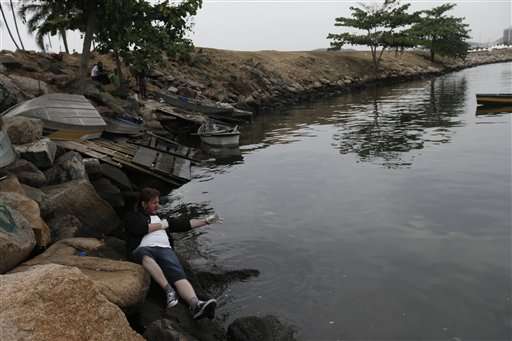
"I've never had infections on my legs. Never!" he wrote on the German sailing team's blog in late August as he underwent painful treatment to scrape the infections off his hips and legs. "The origin must be the Marina da Gloria. In the future, we will try to travel to Rio right before the start of any event, so that any diseases that show up only occur when we are already back home."
In the year preceding the Olympics, AP is examining monthly water samples for three types of human adenovirus as well as enterovirus, rotavirus and bacterial fecal coliforms. The viruses are found in human intestinal and respiratory tracts. They cause digestive illnesses including vomiting, explosive diarrhea and respiratory problems—all of which would knock athletes out of competition. Serious heart and brain disease are also possible, though rare. One type of analysis tests for adenovirus types 2 and 5, markers for the sewage contamination.
Water quality experts say a virus count hitting 1,000 per liter in the U.S. or Europe would cause extreme alarm, leading in many cases to beach closures.
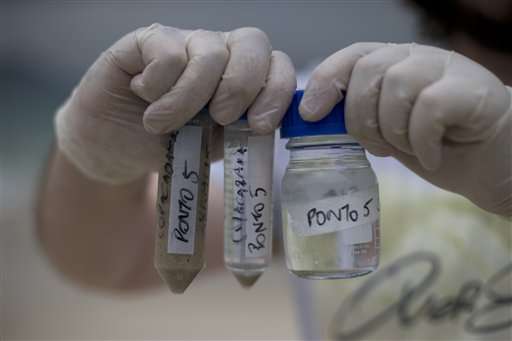
Viral levels were all 30,000 times higher than what is highly alarming in the U.S. or Europe at each of the AP's new offshore sampling sites: at a point 600 meters (yards) offshore and within the Sugarloaf sailing race course; at 1,300 meters (yards) offshore within the Naval School sailing circuit; and at a spot inside the Olympic lagoon where rowing lanes are located, about 200 meters (yards) from shore.
In September tests at the Naval School race course and offshore lagoon points, the water was positive for enterovirus, a major cause of respiratory illness, gastrointestinal ailments and, less often, serious heart and brain inflammation.
Subsequent cell culture testing showed the viruses in the lagoon water to be "active and infectious," but the samples taken from the sailing courses in the bay were not. Mena, the risk assessment expert, said several factors inhibit viruses from growing in a laboratory, but the sheer number of pathogens in Rio's waters means the risk to human health is unacceptable.
Rio de Janeiro state authorities promised to complete sewerage infrastructure near the Marina da Gloria by the end of this year and are making progress. Authorities say Olympic venues will then be safe.
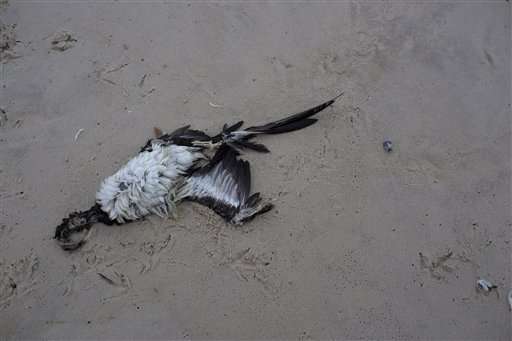
But the high levels of sewage-linked pathogens found in the offshore sailing courses "show that these viruses don't just come from the marina—there are many, many points where sewage enters the bay," Spilki, the Brazilian expert, said. "These pathogens we're looking for, especially the viruses, are able to migrate in the currents in a big way."
Those pollution points are mostly the dozens of rivers that crisscross metropolitan Rio and dump hundreds of millions of liters of raw sewage into the bay each day. By the government's own estimate, just half of the city's wastewater flowing into the bay is treated.
Since the AP report in July exposed the serious risk to athletes, Olympic and World Health Organization officials have flip-flopped over whether they would carry out their own viral testing.
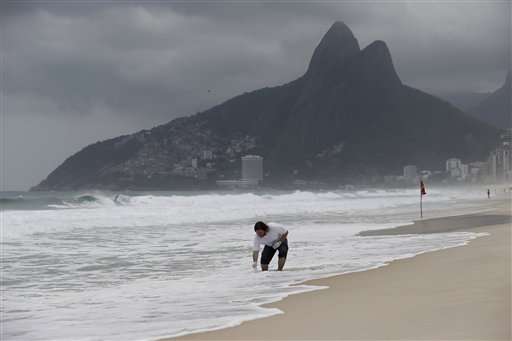
The WHO, which acts in an advisory role to the IOC, took four different positions on whether or not viral testing should be carried out between July and mid-October. In an Oct. 24 email, the WHO told the AP that it didn't feel Olympic officials needed to conduct "routine" viral testing, but added that it was not "unconcerned with viral pathogens in water" and that water quality and monitoring would be discussed in Brazil once again in late November.
Mel Stewart, an American who won two swimming gold medals and a bronze at the 1992 Barcelona Games, said if his daughter were a contender in an open-water swimming competition in Rio, he would tell her not to compete.
"A gold medal is not worth jeopardizing your health," Stewart said. "Right now there are too many questions. I don't see safety. It doesn't appear at this point that the athletes are being thought of first."
-
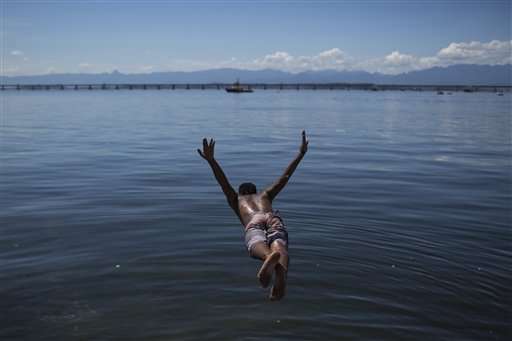
In this Oct. 31, 2015 photo, a young man dives into the polluted waters of Guanabara Bay in Rio de Janeiro, Brazil. Waterborne virus expert Kristina Mena says none of the water venues for the city's 2016 Olympics, including the bay, are safe for swimmers or boaters. (AP Photo/Felipe Dana) -
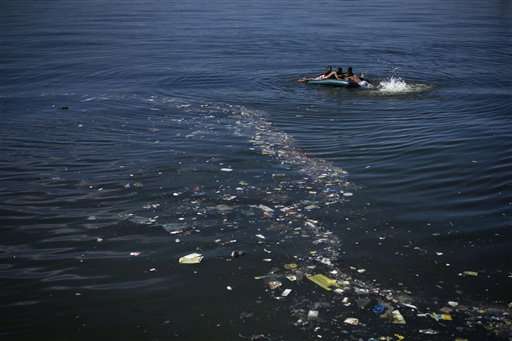
In this Oct. 31, 2015 photo, boys float using an inflatable mattress in Guanabara Bay. Waterborne virus expert Kristina Mena says none of the venues for Rio's 2016 Olympics are fit for swimmers or boaters. Athletes who ingest three teaspoons of water have a 99 percent chance of being infected by viruses. (AP Photo/Felipe Dana) -
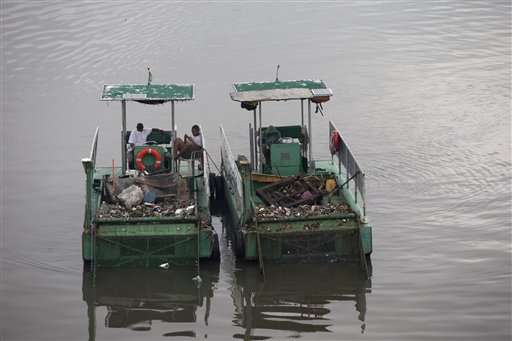
In this Nov. 5, 2015 photo, workers take a rest on two "eco-boats," or garbage-collecting barges, at a canal in Rio de Janeiro, Brazil. The barges are a key part of authorities' efforts to clean up Rio's Guanabara Bay before it and other city waterways host swimming and boating competitions at the 2016 Olympics. (AP Photo/Silvia Izquierdo) -
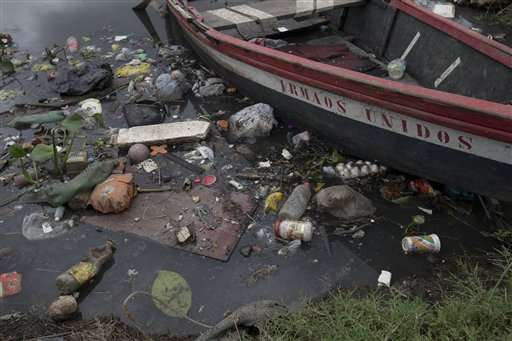
In this Nov. 5, 2015 photo, trash surrounds a boat docked on the banks of the Meriti River, which flows into Guanabara Bay in Rio de Janeiro, Brazil. Rio's waterways, like those of many developing nations, are extremely contaminated because most of the city's sewage is not treated, let alone collected. Massive amounts of it flow straight into Guanabara Bay. (AP Photo/Silvia Izquierdo) -
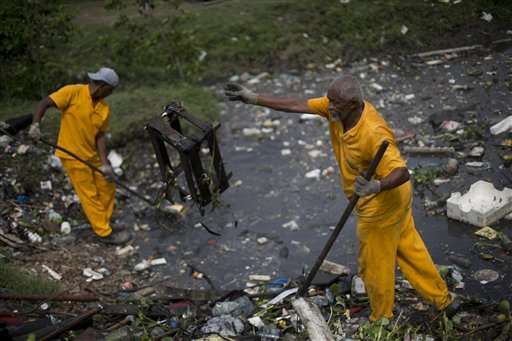
In this Nov. 5, 2015 photo, workers remove garbage collected by floating waste barriers in the Meriti River, which flows into Guanabara Bay in Rio de Janeiro, Brazil. A new round of testing by The Associated Press shows the city's Olympic waterways are as rife with pathogens far offshore as they are nearer land, where raw sewage flows into them from fetid rivers and storm drains. . (AP Photo/Silvia Izquierdo) -
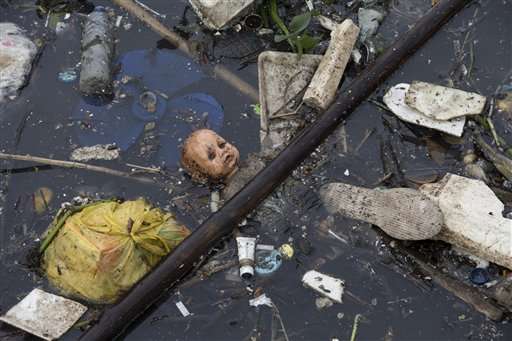
In this Nov. 5, 2015 photo, trash floats in the Meriti River, which flows into Guanabara Bay in Rio de Janeiro, Brazil. The dozens of rivers that crisscross metropolitan Rio dump hundreds of millions of liters of raw sewage into the bay each day. By the government's own estimate, just half of the city's wastewater flowing into the bay is treated. (AP Photo/Silvia Izquierdo) -
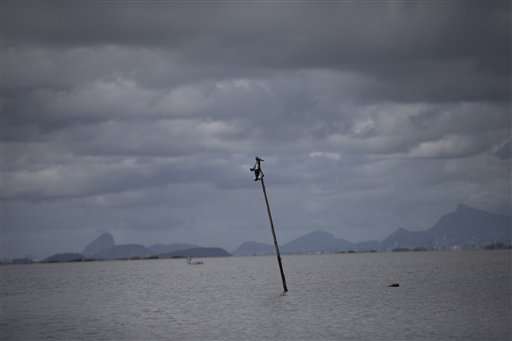
In this Oct. 30, 2015 photo, a plush toy on a wooden stick serves as a marker for entering the Mage River, in Guanabara Bay, in Rio de Janeiro, Brazil. Rio won the right to host the 2016 Olympics based on a bid document that promised to clean up the city's scenic waterways by improving sewage sanitation, a pledge meant to be one of the event's biggest legacies. Brazilian officials now acknowledge that won't happen. (AP Photo/Silvia Izquierdo) -
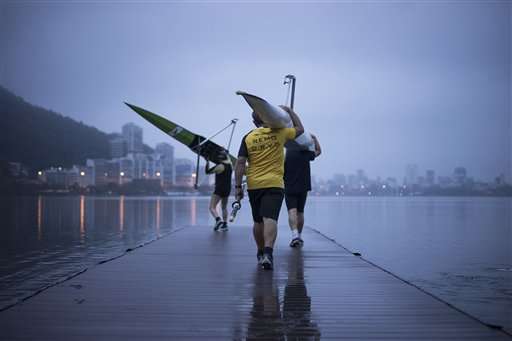
In this Nov. 4, 2015 photo, rowers carry boats at the Rodrigo de Freitas Lagoon in Rio de Janeiro, Brazil. Athletes in Rio test events have tried many tricks and treatments to avoid falling ill from its contaminated waters, including bleaching rowing oars, hosing off their bodies the second they finish competing, and preemptively taking antibiotics, which have no effect on viruses. (AP Photo/Felipe Dana) -
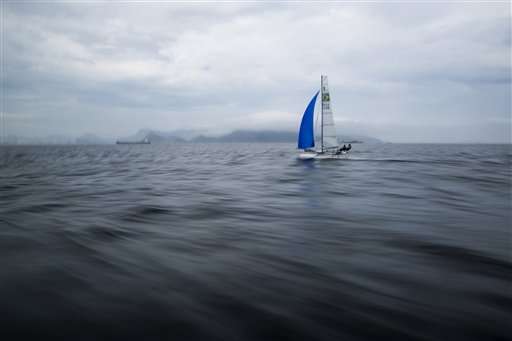
In this Nov. 3, 2015 photo, Brazilian athletes Samuel Albrecht and Isabel Swan practice in Guanabara Bay in Rio de Janeiro, Brazil. Since August, The Associated Press has expanded its testing to include offshore sampling sites inside sailing circuits in the bay and in the middle of the Rodrigo de Freitas Lagoon where rowing and canoeing lanes were located during recent test events. (AP Photo/Felipe Dana)
More information: Interactive, summary findings and methodology of AP's study: interactives.ap.org/2015/brazil-water/
© 2015 The Associated Press. All rights reserved.


















